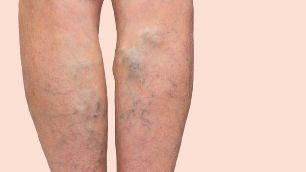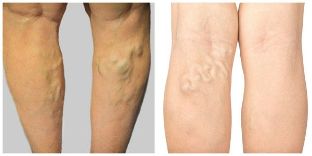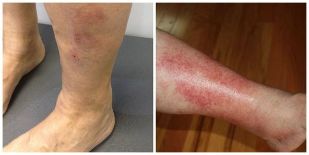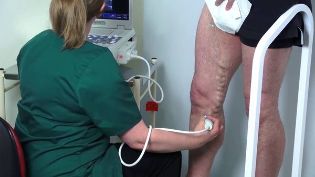The varicose vein disease or varicose veins of the lower limbs is a primary varicose transformation of superficial veins of the lower limbs, which appear as "bumps" or "nodes" on the legs.

Varicose disease is very widespread in the world. Its frequency reaches 60 % among the adult population depending on the country. Interestingly, the inhabitants of the african continent and in the Asia-Pacific region are suffering from the varicose veins is much more rare than the inhabitants of the european countries and the UNITED states.
Because of the absence of a single digit of the causes of varicose veins of the lower limbs agreed to talk about its risk factors, that is to say, which increases the likelihood of development of this pathology (the property or function of the human body, any impact on the body). Generally accepted risk factors for the disease considered, such as age, female gender, obesity and heredity. A typical "portrait" of a patient with symptoms of varicose veins — the woman in the state of menopause, excess body mass index, which has several pregnancy and childbirth in the story.
The symptoms of varicose veins on the legs
In the vast majority of cases, the varicose veins, the disease may recognize, even with no special medical education. An objective sign of pathology, the emergence of "bumps" or "nodes" on the lower limb, with the skin above them do not differ often in a manner or a particular color. The blue veins, generally, are not of the disease in its true sense, even though they often provide patients (most often women) of some of the drawbacks of an aesthetic order.
However, in the case of varicose veins may be accompanied by a color change of the skin due to eczema venous, which manifests itself in various itching skin rash (bubbles, nodules) and redness is.
These signs, coupled with a swelling of the legs, which does not disappear during the night, bear witness to the formation of chronic venous insufficiency.
In regards to symptoms of varicose disease, it should be noted their non-specificity. Complaints can indicate a disease, and can be a sign of an overload of the venous system of the lower limbs. Most often the patient worried of heaviness, sensation of bloating and non-localized slight pain in the calves. Sometimes there are complaints of pain in the area of varicose veins and fatigue of the feet.
A burning sensation, tingling, muscle cramps, night or restless legs syndrome (unpleasant sensations in the legs at rest, when you need them to move, to relieve this discomfort) are more often in the neurological pathology, for example, syndrome root canal, and should be taken into account with caution.
The pathogenesis of varicose veins on the legs
The pathogenesis of varicose veins of the lower limbs is complex and multifaceted. A major role in the mechanism of development of the disease plays the damage to the lining and valves of the veins. Due to their bad operation formed a reverse flow of blood (reflux), then a defeat of the endothelium (the inside of a pavement of the ship), which is accompanied by inflammation.
Later in the disease process are included in the middle and inner layers of the wall of the vein: it goes to the proliferation of the connective tissue in the muscular layer of vienna, iup its atrophy, which leads to the progressive destruction of the collagen in the carcass of the ship. These phenomena violate elastic properties of vienna, to contribute to a widening level, and a spiral clamping of the length. Both these changes are observed in venous valves of the legs.
It should be noted that the visible venous "bumps" and "nodes" are usually the result of the invisible presence of the source of varicose veins, great saphenous vein. In the vast majority of cases, it is great, minus the small subcutaneous vienna. The above changes in the pool of these veins and lead to varicose veins of the disease.
Complications of varicose veins on the legs
Complications of the varicose disease should be food webs of the offence (venous ulcers), thrombosis varicose veins change in the veins (thrombophlebitis) and of variceal bleeding "cones" and "nodes".
Trophic of the violations are the consequence of the progression of the disease in the absence of treatment, it is often takes years and decades to come. They begin with one of the manifestations of the skin — hyperpigmentation (brown spots), eczema and venous lipodermatosclerosis (tightness of the skin).
The main location of these changes, the tibia, although the eczema venous can be observed in the area of the varicose vein, including on the thigh. According to the source of varicose veins (great or small saphenous veins) trophic disorders will be located either internally or on the external surface of the lower third of the tibia, respectively. The result of the violation of the power of the soft tissue used for the formation of venous ulcers changes. The ulcers are single or multiple, with false contours, and gently sloping edges of the screen, with a flat bottom. Celebrated skinny detachable, often purulent in nature. The development of ulcers accompanied by itching and pain. For venous ulcers remarkable is the existence of prolonged (several months) and frequent recurrence.

A thrombophlebitis, or thrombosis of the superficial veins should not be confused with a deep vein thrombosis. In the second case, the situation is much more serious. However, when thrombotic the defeat of varicose veins symptomatology is very unpleasant. In the field of thrombosis of vienna to form painful threadlike joint, it is characterized by redness, increased temperature and increased sensitivity, sometimes attached to limit the movement of the leg. The clinical picture most closely resembles an ulcer or an abscess.
Thrombophlebitis can be particularly dangerous if it takes the advantage of nature and passes on to the surface of the deep system. In this case, it may develop as pulmonary embolism and deep venous thrombosis.
The bleeding of varicose veins varicose veins look very scary, because due to the high pressure venous blood stream is strong enough. In some cases, this can lead to a loss of blood.
The diagnosis of varicose veins on the legs
The diagnosis of varicose veins of the lower extremities do not usually cause any particular difficulties. The key to a sign of the disease serves as the vein of "bumps" and/or "nodes". Although the excessive development of the subcutaneous fat of the lower limbs to see difficult.
To confirm the diagnosis of apply different methods of diagnostic tools leader what is ultrasonic duplex scanning (USD). It allows you to easily, quickly, accurately and safely determine the source of varicose veins, estimating the size and structure of the vessel, the function of venous valves, scale of distribution of the reverse current of blood and to reveal the presence of blood clots. Simultaneously direct and profound, and superficial venous system. To conduct the study, in a standing position or, if the patient's condition does not allow, sitting with his bottom of his legs. The study in the supine position may lead to errors in the determination of reflux and blood clots.
For more assess the function of valves and to the extent the current return of blood to apply:
- pressure tests on the different segments of the lower limbs;
- the test with the draining (the trial of the valsalva maneuver);
- the simulation of walking;
- the receipt of Parana — easy attempt inference to a patient from a state of equilibrium with the aim of a call to the tension of the calf muscles.
The balance sheet duplex ultrasonography, the study of the veins of the lower limbs is necessary to fix in the form of a notice and images, drawing "vein map". The results of the study provide invaluable assistance in the planning of subsequent treatment. However, it is necessary to take into account that in the set with the clinical data, since changes in the ultrasound images in the absence of objective signs of the disease (varicose veins) should be considered to be functional (that is to say, do not have a link with the pathology of the vein). It should also be noted that ultrasound is not necessary if the diagnosis is clear and if the patient does not provide for the treatment of the varicose disease.
There are other diagnostic techniques:
- ultrasound-doppler Ultrasound-the Doppler (not to be confused with USD);
- under the name of plethysmography;
- the radio-opaque venography;
- radiophlébographie;
- a computed tomography (CT);
- magnetic resonance imaging (MRI);
- thermography;
- intravascular ultrasound (IVUS) — a new method.

Treatment of varicose veins on the legs
The main objective of the treatment of varicose veins of the lower limbs is the elimination of all cmas working veins. It is only possible using invasive intervention. There are three ways:
- Delete — combined phlebectomy, short Stripping, minila phlebectomy, dissection of perforating veins;
- "Collage" — sclerotherapy, mechanochemical obliteration, cyanoacrylate fuming obliteration;
- "Brew" — endovenous laser or radiofrequency obliteration.
To achieve the objectives of treatment, you must perform two tasks: eliminating the source of varicose veins (so-called vertical reflux) and clean varicose veins dilated veins. The long period of time is the most often used method has been combined phlebectomy. Its technical implementation involves two steps:
- Ligation anastomosis — the junction of the great saphenous vein with the common femoral vienna (groin);
- The removal of the trunk of the saphenous vein using a probe (Stripping).
This intervention is different raditude and has a number of drawbacks inherent in any operation: frequent need for sedation, incisions and sutures, palpable of the rehabilitation period and to increase when compared to other methods, the risk of development of complications.
But twenty years occurred "phlebology the revolution". It became possible thanks to the widespread adoption of ultrasound and the elegant look of the methodology — endovenous thermal obliteration of the. Its essence lies in the impact of the heat on the wall of a vein to the inside. This is achieved by the laser radiation (EVLO) or exposure to radiofrequency (RFO), "saarialho" the thinning of vienna.
Vienna immediately stop their operation and then gradually resolved. This method allows without incisions, quickly, efficiently, safely and aesthetically eliminate vertical reflux, without the need for further rehabilitation. As a prominent representative of the "office surgery", endovenous thermal obliteration has already ten years, is regarded as the best method of treatment of the varicose disease in the world.
Sclerotherapy (the collage is assigned to vienna, with the help of the introduction into it of a special substance) also has been widely used in the resolution of varicose veins. However, to achieve a result requires careful selection of patients because of the increased risk of recurrence of the disease.
Conservative treatments including compression therapy, phlebotrophic in local medicine and the dosage forms (gels, ointments), a bad sign, only a subsidiary character, working mainly on the symptoms of varicose veins, do not remove the source.
The forecast. Prevention
Considering the modern methods of treatment, the prognosis of varicose veins is favourable. Even if, apparently, cases to solve varicose transformed veins leads to a rapid improvement of the patient's condition.
However, during the planning of the treatment is very important to conduct an assessment of its risk, because any intervention is always carries the potential for adverse effects. The direct responsibility of a physician in order to minimize their chances. Before any manipulation, you must discuss with the patient all the points on the response and obtain its signature in the informed consent.
All adverse effects can be divided into operational risks of surgery, including anesthesia, and the risks of the patient.
Risks of surgery can be small, for example, inflammation (phlebitis) in "brewed" or sklerozirovanie veins, with a joint in their projections and moderate pain syndrome. Can appear on areas of the skin with a low sensitivity, and hyperpigmentation of the skin. All these phenomena are temporary and usually disappear fairly quickly without any consequence.
Major complications include thrombosis of the deep veins, allergic and toxic reactions to the anesthetic drugs. They occur very rarely, but for each patient, who arrived like a complication, the case is 100%, even if the statistics in 1 case out of 10000 operations.

Prevention of venous thrombosis, primarily based on the calculation of its risk on the so-called scale points system with the help of the table Caprini. It contains the various risk factors that have their gradation. The accounting of each factor and the removal of the total score determines the degree of risk and therefore also of prevention. The main tools for prevention of thromboembolic complications venous the following:
- the minimization travmatichnosti of the operation;
- early activation of a patient;
- compression;
- pharmacological prevention, that is to say, the appointment according to the indications of blood-thinning medications, thinning the blood.
And as regards the prevention of the varicose illness, it is simply non-existent, because until now is not clear the main reason for the pathology that could have an impact and therefore, prevent the onset of the disease. For this and quite frequent recurrences of varicose veins after any type of intervention. However, taking account of all the virtues of minimally invasive treatment, this is not a significant problem. Maintain the leg in order pretty simple, the main is the time to ask considering
























